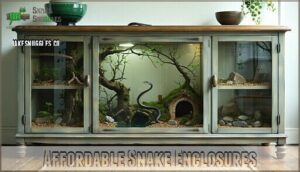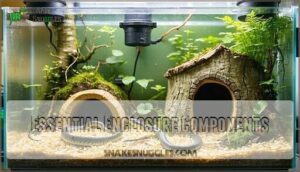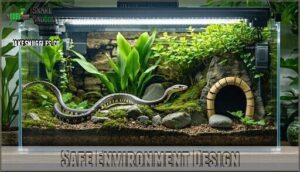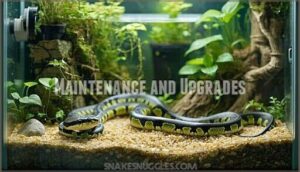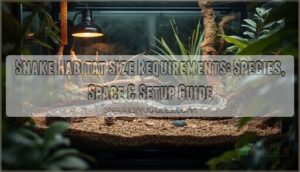This site is supported by our readers. We may earn a commission, at no cost to you, if you purchase through links.
 Affordable snake housing options can be both practical and creative. Consider plastic storage tubs with secure lids—they’re cheap, easy to modify, and great for smaller snakes.
Affordable snake housing options can be both practical and creative. Consider plastic storage tubs with secure lids—they’re cheap, easy to modify, and great for smaller snakes.
For a more polished look, repurpose old furniture like bookshelves or cabinets; just add plexiglass and ventilation. DIY wooden enclosures are budget-friendly but make certain you use untreated, snake-safe materials.
Stick to basic substrates like newspaper or kraft paper to save money, and use under-tank heaters or heat tape for warmth without breaking the bank. Don’t forget thrift stores and local classifieds for affordable material.
A little creativity goes a long way toward building the perfect setup!
Table Of Contents
- Key Takeaways
- Affordable Snake Enclosures
- Essential Enclosure Components
- Safe Environment Design
- Temperature Regulation
- Maintenance and Upgrades
- Frequently Asked Questions (FAQs)
- What type of housing does a snake need?
- Is a 50 gallon tank enough for a corn snake?
- What is the best habitat for snakes?
- What to put in the bottom of a snake tank?
- Should you upgrade your snake’s enclosure?
- Do snakes need a vertical enclosure?
- How do I keep snakes out of my enclosure?
- How do I choose a substrate for a snake?
- What is the best enclosure for a snake?
- Where is the best place to keep a snake?
- Conclusion
Key Takeaways
- Use plastic storage tubs or repurpose old furniture like bookshelves and cabinets for budget-friendly snake enclosures.
- DIY wooden enclosures can be affordable but ensure materials are untreated and safe for snakes.
- Stick to simple substrates like newspaper or kraft paper and use under-tank heaters or heat tape for warmth.
- Opt for budget brands, thrift stores, or local classifieds to find affordable enclosures and materials.
Affordable Snake Enclosures
In the pursuit of finding affordable snake enclosures, you have plenty of options that won’t break the bank.
From budget-friendly brands to DIY projects and repurposed furniture, there are cost-effective solutions for creating a safe and comfortable home for your snake.
Budget-Friendly Enclosure Brands
When searching for affordable snake enclosures, explore alternative brands like Sog Plastics or Zen Habitats for cost-effective PVC options.
Kages offers competitive snake enclosure price ranges for larger setups, while Sterilite provides budget-friendly DIY kits.
Check discount retailers or used marketplaces for deals. Sog Plastics offers enclosures suitable for reptiles.
Comparing snake enclosure models helps balance affordability and function, ensuring snake housing remains practical without breaking the bank, and provides a practical solution.
DIY Snake Enclosure Ideas
You can turn simple materials into affordable snake enclosures with creativity and effort.
Transform basic materials into budget-friendly snake enclosures with creativity, ensuring safety, comfort, and a personal touch for your reptile.
For a homemade snake cage, try these ideas:
- Cabinet Conversions: Lay cabinets on their side for space and add glass doors.
- Custom Backdrops: Use vinyl flooring for durability and easy cleaning.
- Pallet Enclosures: Repurpose wood for rustic, eco-friendly frames.
Snake enclosure DIY saves money and adds personality! Consider species specific needs for your snake.
Repurposing Old Furniture for Enclosures
Old furniture can make a great upcycled snake habitat with a few modifications.
Verify furniture suitability by picking sturdy, smooth pieces. Address safety concerns by sealing edges and adding ventilation.
Cabinet conversions are popular for affordable snake housing—just remove shelves and replace back panels. This DIY snake cage approach offers cost savings and aesthetic integration, perfectly balancing function and style.
Essential Enclosure Components
To create a proper habitat for your snake, focus on the essentials like size, material, heat sources, and humidity control.
These components guarantee your pet stays healthy, comfortable, and secure without overspending.
Choosing The Right Size and Material
Getting the right snake enclosure size and material is key.
Follow a snake enclosure size guide: bigger is better for adult snakes, ensuring space for movement.
PVC enclosures are affordable snake housing with great heat retention and humidity control.
Opt for easy-to-clean materials and prioritize material safety to avoid toxins.
Spacious dimensions support heating setups and proper substrate options effortlessly.
Selecting Affordable Substrate Options
When setting up an affordable snake tank, substrates matter for comfort and safety.
For budget reptile habitats, consider Substrate Cost Analysis: pool filter sand costs about $15-$20 for 50 lbs, and all-purpose gravel is just $5 for 20 lbs.
Both are excellent DIY substrate options, easy to clean, and perfect for maintaining a naturalistic look in plastic snake bins.
These choices also align with species-specific needs, ensuring the snake’s comfort and well-being.
Incorporating Heating Elements on a Budget
After picking an affordable substrate, think about adding heat sources for temperature control.
DIY heat mats are a simple option, and ceramic heaters work well in a cheap snake cage, especially paired with used equipment.
Always use thermostat control for safety, and consider purchasing DIY materials for reptile heating to keep your habitat safe and efficient.
With smart choices, a budget reptile habitat stays cozy, and by keeping safety measures in mind to avoid burns, you can create a comfortable environment for your reptile.
Safe Environment Design
When designing a safe environment for your snake, focus on replicating their natural habitat to promote comfort and health.
Use secure climbing structures, proper hides, and snake-safe decorations to create a functional and stress-free enclosure.
Creating a Naturalistic Snake Habitat
To create a naturalistic snake habitat, mimic their environment with moisture-holding substrates like bioactive reptile bedding.
Use naturalistic lighting to simulate day and night cycles.
Add water features for hydration and vertical space for climbing.
Include enclosure accessories like plants and elements for foraging, these enrichment activities help your snake feel at home while maintaining proper humidity and temperature levels, ensuring a comfortable environment with proper humidity.
Incorporating Climbing Structures and Hides
To make snake enclosures enriching, focus on climbing safety and cozy spots.
Focus on climbing safety and cozy spots to create an enriching, stress-free environment your snake will love.
Secure hides and proper branch placement keep snakes feeling safe and active. Proper hides also help to reduce stress in snakes.
Aim for affordable housing using items like:
- Cork bark or PVC pipes for cave hides.
- Driftwood as natural snake decor.
- Fake vines for flexible climbing.
- Repurposed storage boxes for hide materials.
- Sanded branches for secure climbing spots.
Using these materials can help create an environment that promotes active snakes, which is essential for their well-being.
Choosing Snake-Safe Plants and Decorations
Choose safe plant species and decorations to enhance your snake’s vivarium.
Avoid items with decoration toxicity risks or sharp edges to prevent ingestion risks.
Use nontoxic materials, ensuring plants and snake decor are easily cleaned.
Incorporate enrichment benefits by mimicking naturalistic vivarium design with climbing branches, hides, and snake-safe plants.
Consider snake-safe plant options for a secure habitat.
Prioritize animal safety to support your snake’s mental health.
Temperature Regulation
Keeping your snake’s enclosure at the right temperature is essential for their health and comfort.
You can create an ideal environment by setting up a gradient, using budget-friendly heating options, and monitoring temperatures with accurate thermometers to ensure their health.
Establishing a Temperature Gradient
Creating a snake enclosure temperature gradient guarantees their comfort and health.
Set up a basking spot at 87-92°F and a cool zone around 75-80°F. Use heat sources like mats or lamps to balance zones.
Snake temperature needs vary, so gradient monitoring is key. Thermoregulation supports digestion and overall health.
Thermostat calibration helps maintain stable heat gradients, essential for effective snake enclosure heat management.
Using Affordable Heating Sources
Affordable heating options keep your setup safe and functional without busting the budget.
Heat mats are energy-efficient but always use thermostats to prevent overheating. Ceramic heat emitters provide steady warmth, especially at night. Radiant heat panels are low-maintenance and effective.
- Use thermostats: Essential for safety.
- DIY heat rocks: Creative and cost-friendly.
- Alternative heat sources: Boost efficiency affordably!
Monitoring Temperature With Thermometers
You’ve set up affordable heating, but how do you keep your snake comfy?
Thermometer placement is key.
Use digital or analog thermometers to check your temperature gradient—cooler areas should hit 75–80°F.
Don’t forget calibration methods for accuracy.
Here’s a quick guide:
| Feature | Digital Thermometer | Analog Thermometer | Remote Monitoring |
|---|---|---|---|
| Accuracy | High | Moderate | High |
| Price Range | $10–$30 | $5–$15 | $20–$50 |
| Maintenance | Low | Moderate | Low |
| Ambient Temp Log | Yes | No | Yes |
Maintenance and Upgrades
Keeping your snake’s enclosure clean and updated is essential for its health and comfort.
Regular maintenance and thoughtful upgrades can also extend the life of your setup while staying within a budget.
Establishing a Regular Cleaning Routine
Keeping your snake’s enclosure clean is key for its health.
Stick to routine maintenance by following these quick steps:
- Spot-clean daily to manage waste disposal and bacteria removal.
- Change the substrate fully every 4-6 weeks to prevent mold.
- Use snake-safe disinfecting methods weekly for hygiene.
- Check corners, hides, and decorations regularly to stop moisture buildup and ensure bacteria removal.
Addressing Waste Management and Odor Control
Managing snake waste and odors starts with smart substrate choice—moisture-holding substrates like cypress mulch help minimize bacteria buildup.
Stick to a consistent cleaning frequency, removing waste daily and deep cleaning monthly.
Use odor neutralizers sparingly and focus on proper ventilation methods to prevent smells.
Maintain drainage and moisture retention balance to maintain healthy conditions during snake enclosure maintenance.
Upgrading and Renovating Affordable Enclosures
Upgrade your snake’s enclosure by focusing on safety and enrichment.
Add automation options like thermostats or timers for consistent conditions.
Optimize space with customized layouts or upcycled snake habitats like modified plastic tubs or melamine enclosures.
Enhance aesthetics with natural decorations, while ensuring safety enhancements like smooth edges.
DIY snake terrariums or secondhand reptile tanks are practical, budget-friendly renovation ideas.
Frequently Asked Questions (FAQs)
What type of housing does a snake need?
A snake’s housing should mimic its natural habitat, offering space to move, climb, and hide.
Use enclosures with proper heat, humidity, and lighting.
Include hiding spots, secure lids, and easy-to-clean materials for safety.
Is a 50 gallon tank enough for a corn snake?
Yes, a 50-gallon tank works well for an adult corn snake.
It gives them space to move, hide, and climb.
Make sure to create proper heat gradients and include hides for comfort and security.
What is the best habitat for snakes?
The best snake habitat mimics its natural environment.
Use an enclosure with proper size, temperature gradients, 60-70% humidity, and safe hides.
Include climbing branches and secure ventilation.
Make certain everything’s clean and escape-proof for their safety.
What to put in the bottom of a snake tank?
Use a reptile-safe substrate like aspen shavings, cypress mulch, or coconut fiber to absorb moisture and maintain humidity.
Avoid loose sand or cedar, which can harm your snake’s skin and respiratory health.
Should you upgrade your snake’s enclosure?
When your snake outgrows its current enclosure or its needs change, upgrading guarantees comfort and health.
A roomier, well-equipped space supports natural behaviors, makes thermoregulation easier, and helps prevent stress for a thriving pet.
Do snakes need a vertical enclosure?
Not all snakes need a vertical enclosure, but semi-arboreal species, like ball pythons, enjoy climbing.
Providing some height lets them explore while feeling secure.
Focus on their natural behavior when choosing enclosure dimensions, considering the need for vertical space.
How do I keep snakes out of my enclosure?
Block any gaps in the enclosure with silicone or mesh to prevent intruders.
Place the habitat in a secure area, avoid leaving food exposed nearby, and regularly check for signs of breaches or pests.
How do I choose a substrate for a snake?
Did you know different substrates affect humidity.
Choose based on your snake’s needs. Aspen shavings work for dry habitats, while coconut fiber retains moisture.
Avoid cedar—it’s toxic. Always spot-clean and replace substrate regularly for health.
What is the best enclosure for a snake?
The ideal snake enclosure depends on your snake’s size and species.
Choose a spacious, ventilated setup with secure doors.
PVC cages are great for maintaining heat and humidity, while glass terrariums offer excellent visibility.
Where is the best place to keep a snake?
Place your snake in a quiet, low-traffic area of your home.
Avoid direct sunlight, drafts, or extreme temperature changes.
A stable, calm environment helps your snake feel secure and reduces stress.
Conclusion
At the end of the day, affordable snake housing options don’t have to cost an arm and a leg.
With a little planning and effort, you can create a safe, comfortable, and budget-friendly habitat for your snake.
From repurposing items to DIY projects, the possibilities are endless.
Prioritize snake-safe materials, proper heating, and ventilation to guarantee their health.
By thinking creatively and staying resourceful, you’ll build a setup your snake will thrive in without overspending.

